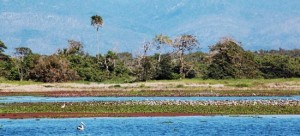
The wetlands have been invaded by introduced weeds as a result of human-built structures, which have changed the hydrology of the water and allowed the weeds to grow. This has dramatically reduced the wetlands’ biodiversity over the years. In 2004, the Nywaigi People could see the wetlands were endangered and made a plan with the CSIRO (Commonwealth Scientific and Industrial Research Organisation) to restore and protect them. In June 2012, they received a grant under the Clean Energy Future’s associated program, the Biodiversity Fund, to begin work. It’s a partnership and a project that has a good chance of bringing the wetlands back from the brink of destruction.
One of the big problems in the wetlands has been the invasion of the plant Olive Hymenachne. Originally introduced as food for cattle, it is now a declared pest plant and weed of national significance.
“The partnership with the Traditional Owners has been rewarding. We were researching the species and the Nywaigi People were interested in management of a number of projects to address Hymenachne on their wetlands,” CSIRO scientist Tony Grice says.
“The Nywaigi People had a series of projects to implement and we developed a strategy with them to assist in the restoration of the wetlands. The most recent project will remove an earth wall that was built years ago between the saline and the freshwater wetlands. This wall changes the hydrology of the water, which creates habitat for invasive species. Restoring the hydrology and revegetation will improve biodiversity.”
Making a start
Through modelling, the CSIRO will be able to predict what will happen when the earth wall is removed. It’s thought the wall was originally created to hold the seawater back and create more freshwater so that the wetlands would support pasture grazing and agriculture. However through revegetation and aerial spraying of the invasive weeds, combined with some burning off, the wetlands are slowly coming back.
“We’ve made a good deal of progress to
get the Olive Hymenachne less destructive to the biodiversity of the wetlands.
It is basically high biomass grass that reduces the quality of the habitat – bird life is reduced, plants die in the water and the quality of the water is reduced. That creates barriers to fish and other life moving through the water,” Tony says.
The project aims to get the weeds under control first, then plant native trees and plants along creeks that lead into the wetlands and along the edges of the wetland.
Plants and bird species returning
“You get a positive response
from remnants when you take away invasive weeds. Things
like wild rice and other native plant species return. They are
an important food source for the Brolgas and other bird species.
Since the work began we have seen that some of the iconic bird species that use the wetlands have returned. One lagoon is now rich in bird species,” Tony says.
The Traditional Owners have driven the partnership from the beginning and are actively involved in restoring the wetlands.
“They are doing the bulk of the hands-on work and they will be employing a full-time person from the community in the near future to look after weed control. We work closely with them across all facets of the project,” Tony says.
Manager of Mungalla, Jacob Cassady agrees the partnership with the CSIRO has been invaluable in restoring the wetlands.
“It’s absolutely vital that this country is restored. Like everywhere in Australia our songlines are here and it is a significant site for us. The Aboriginal relationship with country, even when people are disconnected, is always there,” Jacob says.
“When your country has been degraded, it’s devastating, and that comes from clearing and the introduction of weeds. I took one of our Elders down to the wetlands and its tributaries recently. He told stories of when he was there as a boy and he could see the Barramundi at the bottom of the creek just by looking. The look on his face when he saw that same creek told me he knew how much degradation had occurred.
“We say that a healthy country has healthy people.”
Restoring the wetlands has also been good for the Nywaigi youth, Jacob says.
“We had a youth problem about seven years ago when we began to work with CSIRO on the wetlands. The wetlands projects have helped our youth connect with country and educate them on culture. We hold camps here aimed at educating our young people and getting them involved. We take them out and show them the impact of the weeds because they need to grasp the vision.”
But he, too, is hopeful that, in time, the wetlands will return to their natural state.
“I recently saw a black swan here for the first time in years. People do need to realise how devastating weeds can be to country. On Mungalla’s property we get an income from our cattle but they are not near our wetlands. Everything must be in balance. You have got to have that balance.”

Comments are closed.